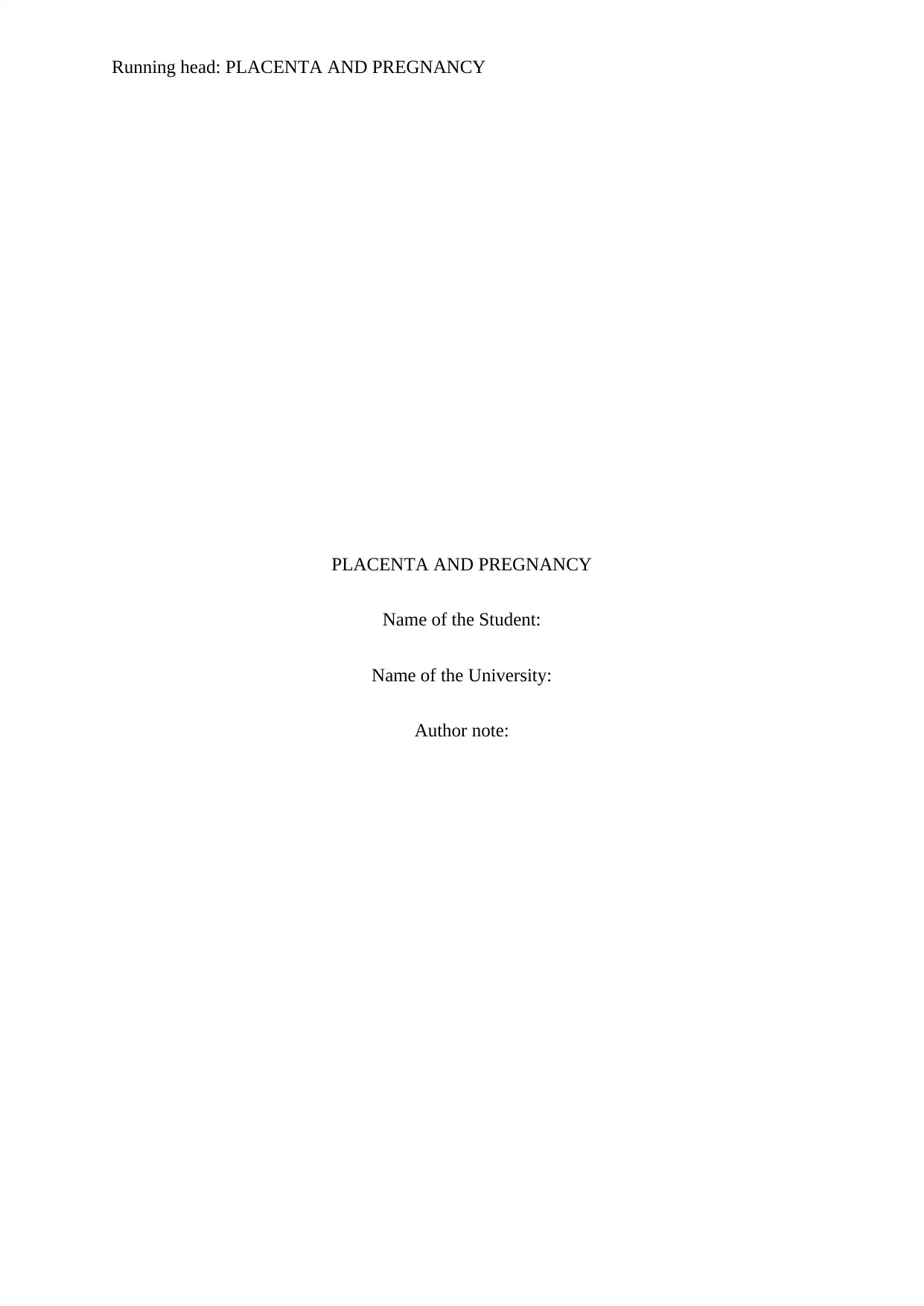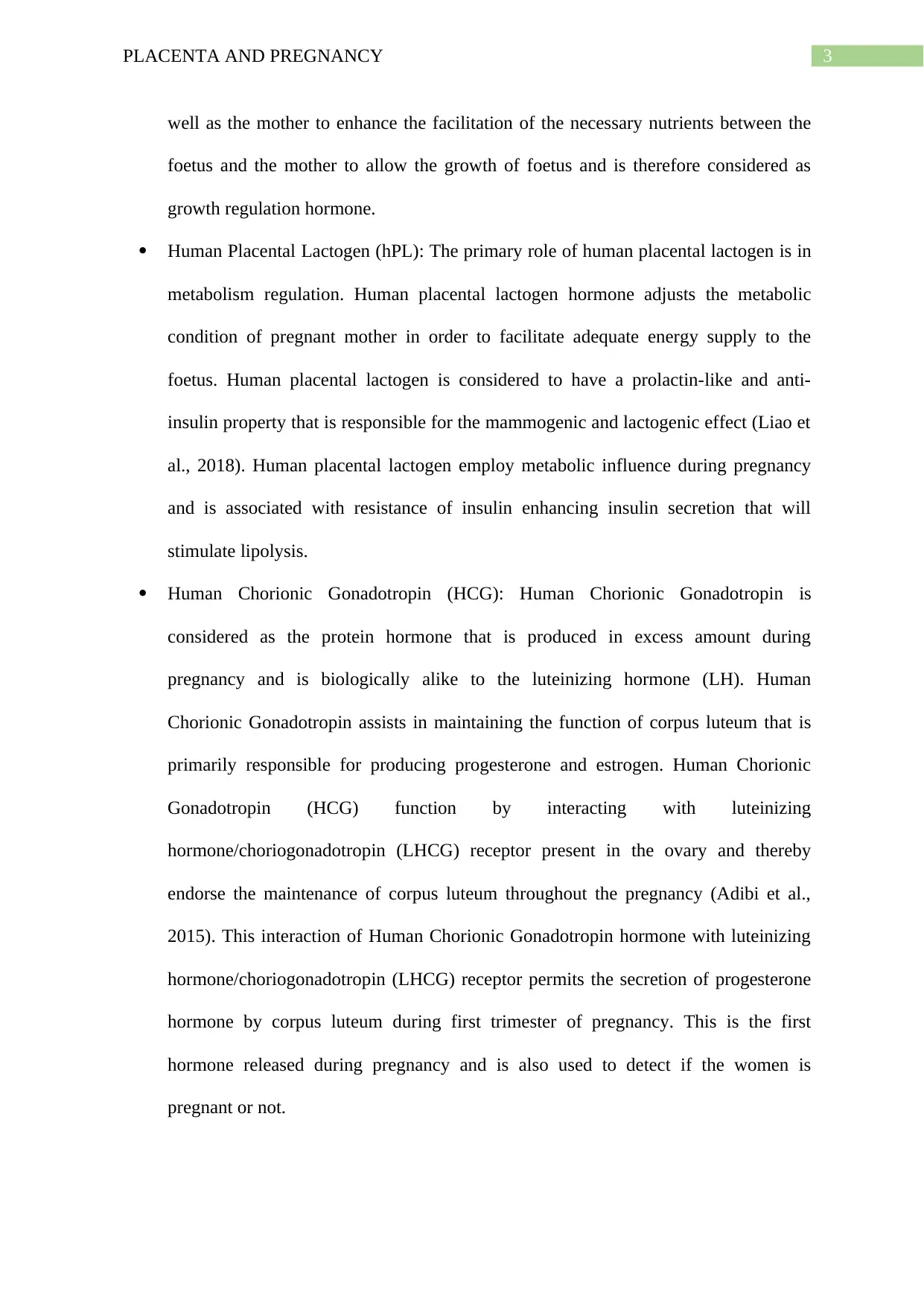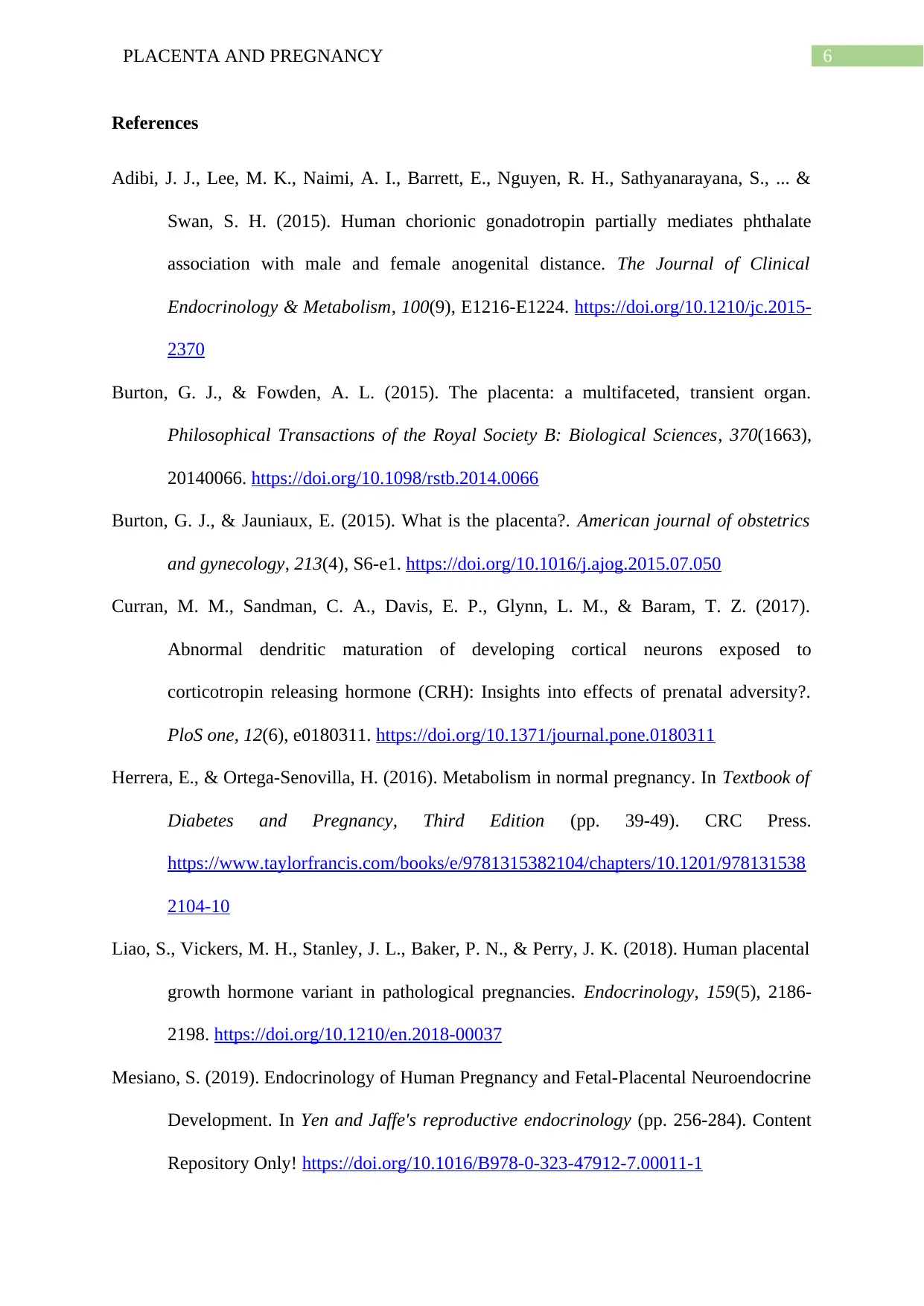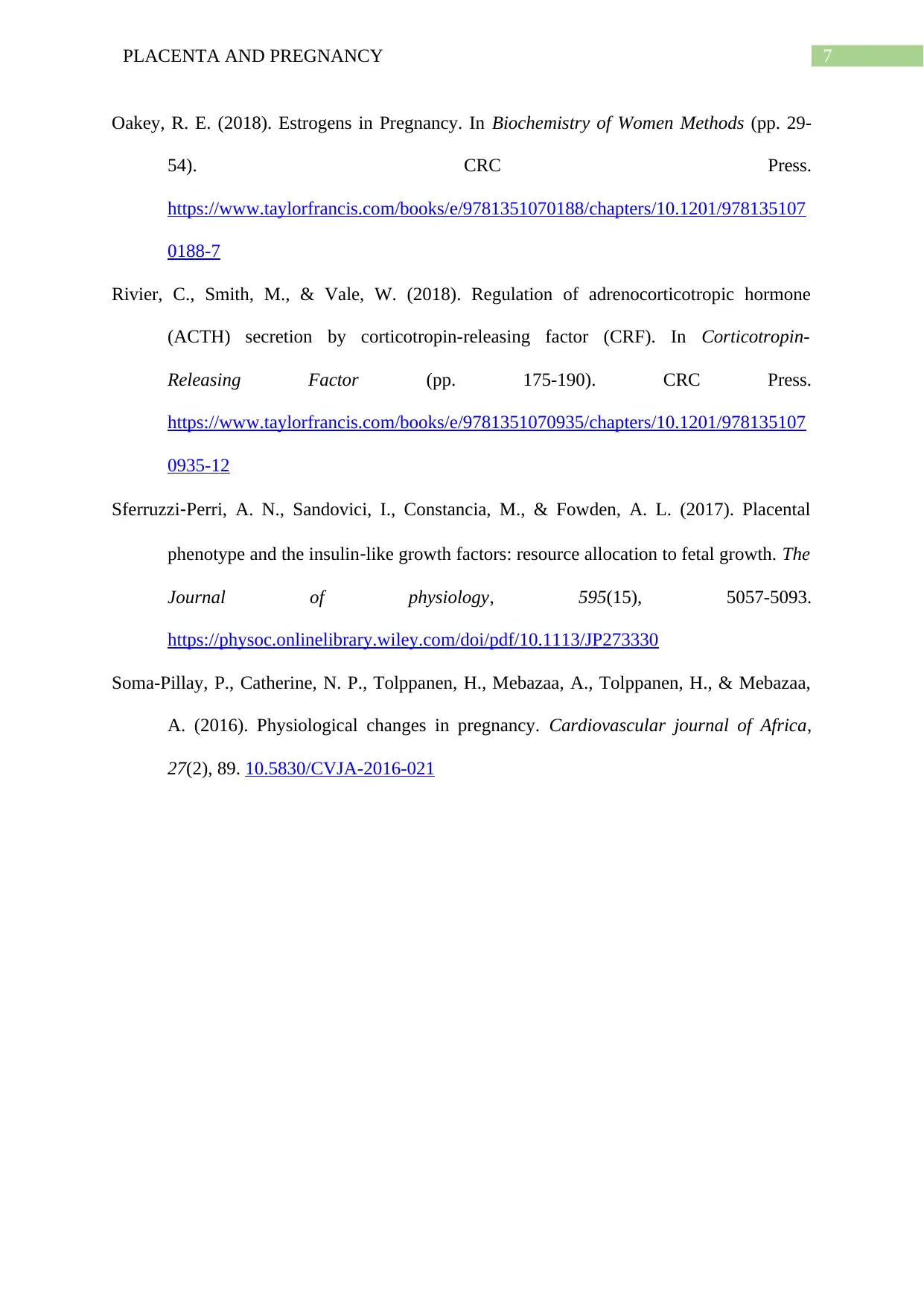MIDW1018: Anatomy & Physiology - Hormonal Basis of Placenta
VerifiedAdded on 2023/03/29
|8
|1380
|53
Report
AI Summary
This report delves into the hormonal mechanisms underlying placenta establishment and development during pregnancy. It identifies key hormones, including Human Chorionic Gonadotropin (hCG), Oestrogen, Progesterone, and Corticotropin Releasing Hormone (cRH), involved in the initial stages of placenta formation. Furthermore, it discusses hormones produced by the placenta towards the end of the first trimester, such as Placental Growth Hormone (GH), Human Placental Lactogen (hPL), Adrenocorticotropic hormone (ACTH), and Corticotropin Releasing Hormone (CRH), detailing their roles in fetal growth, metabolic regulation, and stress response. The report elucidates the major roles and mechanisms of action of seven of these hormones in ensuring a healthy placenta and pregnancy, emphasizing their importance in regulating fetal development and maternal metabolic adaptation. This includes regulating the growth and development of the human foetus and it also enhances the metabolic condition of the pregnant mother in order to enable adequate energy supply to the foetus.

Running head: PLACENTA AND PREGNANCY
PLACENTA AND PREGNANCY
Name of the Student:
Name of the University:
Author note:
PLACENTA AND PREGNANCY
Name of the Student:
Name of the University:
Author note:
Paraphrase This Document
Need a fresh take? Get an instant paraphrase of this document with our AI Paraphraser

1PLACENTA AND PREGNANCY
Answer 1)
The placenta is considered as the temporary organ, which connects the foetus nurturing in
the mother’s womb to the mother through the umbilical cord. There are different hormones
that is released during pregnancy and result in the establishment of the placenta (Burton &
Fowden, 2015). Human Chorionic Gonadotropin hormone is the primary hormone that is
released initially for the development of placenta and is also used for detecting if a women is
pregnant or not. There are various hormones that lead to the development of the placenta that
includes the (Mesiano, 2019):
Human Chorionic Gonadotropin (hCG)
Oestrogen
Progesterone
Corticotropin Releasing Hormone (cRH).
Answer 2)
Placenta is defined as the temporary organ that primarily develops during pregnancy in
the uterus of the pregnant mother (Burton & Jauniaux, 2015). The primary purpose of
placenta is provide adequate nutrients and oxygen to the foetus and also remove any waste
content from the blood of the foetus. There are various hormones produced by the placenta
towards the end of the first trimester of pregnancy some of them are as follows (Soma et al.,
2016):
Placental Growth Hormone (GH): It is also known as growth hormone 2 (GH2) or
growth hormone variant (GHV) and considered as a protein, which is encrypted by
Gh2 gene and released during pregnancy that is crucial for growth control regulation.
Answer 1)
The placenta is considered as the temporary organ, which connects the foetus nurturing in
the mother’s womb to the mother through the umbilical cord. There are different hormones
that is released during pregnancy and result in the establishment of the placenta (Burton &
Fowden, 2015). Human Chorionic Gonadotropin hormone is the primary hormone that is
released initially for the development of placenta and is also used for detecting if a women is
pregnant or not. There are various hormones that lead to the development of the placenta that
includes the (Mesiano, 2019):
Human Chorionic Gonadotropin (hCG)
Oestrogen
Progesterone
Corticotropin Releasing Hormone (cRH).
Answer 2)
Placenta is defined as the temporary organ that primarily develops during pregnancy in
the uterus of the pregnant mother (Burton & Jauniaux, 2015). The primary purpose of
placenta is provide adequate nutrients and oxygen to the foetus and also remove any waste
content from the blood of the foetus. There are various hormones produced by the placenta
towards the end of the first trimester of pregnancy some of them are as follows (Soma et al.,
2016):
Placental Growth Hormone (GH): It is also known as growth hormone 2 (GH2) or
growth hormone variant (GHV) and considered as a protein, which is encrypted by
Gh2 gene and released during pregnancy that is crucial for growth control regulation.

2PLACENTA AND PREGNANCY
Human Placental Lactogen (hPL): It is also known as human chorionic
somatomammotropin (HCS) that is considered as the polypeptide placental hormone
that will help the foetus to grow.
Human Chorionic Gonadotropin (hCG): This is the first hormone that is released
during pregnancy and which assist the egg to nourish and help in development of
foetus (Herrera & Ortega, 2016).
Adrenocorticotropic hormone (ACTH): It is considered as a tropic hormone that is
produced within the anterior pituitary region.
Corticotropin Releasing Hormone (CRH): It is also known as corticotropin-releasing
factor (CRF) that is considered as the peptide hormone and is released in the fetal and
maternal circulation.
Oestrogen: Oestrogen is released from corpus luteum present in the ovaries that is
required for foetal growth thereby stimulating the womb lining of the pregnant mother
to generate essential nutrients that is required for the growth and development of the
foetus.
Answer 3)
The above mentioned seven hormones are produced by the placenta during the pregnancy
that is essential for the growth and development of the foetus. The major role and mechanism
of action of each of the above mentioned hormones are explained in detail that will help in
establishing a healthy placenta ad pregnancy are as follows:
Placental Growth Hormone (GH): The primary role of placental growth hormone is
regulating the growth and development of the human foetus and it also enhances the
metabolic condition of the pregnant mother in order to enable adequate energy supply
to the foetus (Sferruzzi et al., 2017). This hormone is produced by the foetus and as
Human Placental Lactogen (hPL): It is also known as human chorionic
somatomammotropin (HCS) that is considered as the polypeptide placental hormone
that will help the foetus to grow.
Human Chorionic Gonadotropin (hCG): This is the first hormone that is released
during pregnancy and which assist the egg to nourish and help in development of
foetus (Herrera & Ortega, 2016).
Adrenocorticotropic hormone (ACTH): It is considered as a tropic hormone that is
produced within the anterior pituitary region.
Corticotropin Releasing Hormone (CRH): It is also known as corticotropin-releasing
factor (CRF) that is considered as the peptide hormone and is released in the fetal and
maternal circulation.
Oestrogen: Oestrogen is released from corpus luteum present in the ovaries that is
required for foetal growth thereby stimulating the womb lining of the pregnant mother
to generate essential nutrients that is required for the growth and development of the
foetus.
Answer 3)
The above mentioned seven hormones are produced by the placenta during the pregnancy
that is essential for the growth and development of the foetus. The major role and mechanism
of action of each of the above mentioned hormones are explained in detail that will help in
establishing a healthy placenta ad pregnancy are as follows:
Placental Growth Hormone (GH): The primary role of placental growth hormone is
regulating the growth and development of the human foetus and it also enhances the
metabolic condition of the pregnant mother in order to enable adequate energy supply
to the foetus (Sferruzzi et al., 2017). This hormone is produced by the foetus and as
⊘ This is a preview!⊘
Do you want full access?
Subscribe today to unlock all pages.

Trusted by 1+ million students worldwide

3PLACENTA AND PREGNANCY
well as the mother to enhance the facilitation of the necessary nutrients between the
foetus and the mother to allow the growth of foetus and is therefore considered as
growth regulation hormone.
Human Placental Lactogen (hPL): The primary role of human placental lactogen is in
metabolism regulation. Human placental lactogen hormone adjusts the metabolic
condition of pregnant mother in order to facilitate adequate energy supply to the
foetus. Human placental lactogen is considered to have a prolactin-like and anti-
insulin property that is responsible for the mammogenic and lactogenic effect (Liao et
al., 2018). Human placental lactogen employ metabolic influence during pregnancy
and is associated with resistance of insulin enhancing insulin secretion that will
stimulate lipolysis.
Human Chorionic Gonadotropin (HCG): Human Chorionic Gonadotropin is
considered as the protein hormone that is produced in excess amount during
pregnancy and is biologically alike to the luteinizing hormone (LH). Human
Chorionic Gonadotropin assists in maintaining the function of corpus luteum that is
primarily responsible for producing progesterone and estrogen. Human Chorionic
Gonadotropin (HCG) function by interacting with luteinizing
hormone/choriogonadotropin (LHCG) receptor present in the ovary and thereby
endorse the maintenance of corpus luteum throughout the pregnancy (Adibi et al.,
2015). This interaction of Human Chorionic Gonadotropin hormone with luteinizing
hormone/choriogonadotropin (LHCG) receptor permits the secretion of progesterone
hormone by corpus luteum during first trimester of pregnancy. This is the first
hormone released during pregnancy and is also used to detect if the women is
pregnant or not.
well as the mother to enhance the facilitation of the necessary nutrients between the
foetus and the mother to allow the growth of foetus and is therefore considered as
growth regulation hormone.
Human Placental Lactogen (hPL): The primary role of human placental lactogen is in
metabolism regulation. Human placental lactogen hormone adjusts the metabolic
condition of pregnant mother in order to facilitate adequate energy supply to the
foetus. Human placental lactogen is considered to have a prolactin-like and anti-
insulin property that is responsible for the mammogenic and lactogenic effect (Liao et
al., 2018). Human placental lactogen employ metabolic influence during pregnancy
and is associated with resistance of insulin enhancing insulin secretion that will
stimulate lipolysis.
Human Chorionic Gonadotropin (HCG): Human Chorionic Gonadotropin is
considered as the protein hormone that is produced in excess amount during
pregnancy and is biologically alike to the luteinizing hormone (LH). Human
Chorionic Gonadotropin assists in maintaining the function of corpus luteum that is
primarily responsible for producing progesterone and estrogen. Human Chorionic
Gonadotropin (HCG) function by interacting with luteinizing
hormone/choriogonadotropin (LHCG) receptor present in the ovary and thereby
endorse the maintenance of corpus luteum throughout the pregnancy (Adibi et al.,
2015). This interaction of Human Chorionic Gonadotropin hormone with luteinizing
hormone/choriogonadotropin (LHCG) receptor permits the secretion of progesterone
hormone by corpus luteum during first trimester of pregnancy. This is the first
hormone released during pregnancy and is also used to detect if the women is
pregnant or not.
Paraphrase This Document
Need a fresh take? Get an instant paraphrase of this document with our AI Paraphraser

4PLACENTA AND PREGNANCY
Adrenocorticotropic hormone (ACTH): Adrenocorticotropic hormone is produced and
secreted within the pituitary gland located in the brain. Adrenocorticotropic hormone
is required for the adrenal glands to function properly and assist the human body to
react under stressful condition. Adrenocorticotropic hormone (ACTH) stimulate or
initiate the discharge of another hormone known as cortisol located in the cortex
present within the adrenal gland (Rivier, Smith & Vale, 2018). The primary function
of adrenocorticotropic hormone (ACTH) is to control the level of steroid hormone
named cortisol that is released through the adrenal gland.
Corticotropin Releasing Hormone (CRH): Corticotropin Releasing Hormone is also
termed as corticotropin-releasing factor (CRF) that is considered as the peptide
hormone and function during stress response. The primary purpose of the
Corticotropin Releasing Hormone (CRH) is to stimulate the pituitary synthesis of
Adrenocorticotropic hormone (ACTH) that is considered as the part of HPA Axis.
Corticotropin Releasing Hormone is produced and secreted by para ventricular
nucleus (PNV) present within the hypothalamus and is usually secreted during stress
response (Curran et al., 2017). This hormone is released in the feral and maternal
circulation present within the placenta that is crucial for the development and growth
of the foetus.
Oestrogen: Oestrogen is the female sex hormone that is produced by the endocrine
system and travels through the blood. The primary role of Oestrogen is to help or
support the uterus to grow effectively and maintain the uterus lining during the total
time of pregnancy. This hormone is produced by ovary and later it is produced by
placenta (Oakey, 2018). There are other primary function of Oestrogen like enhancing
blood circulation, activating and regulating the production of hormones and
enhancing the blood circulation between the mother and the foetus.
Adrenocorticotropic hormone (ACTH): Adrenocorticotropic hormone is produced and
secreted within the pituitary gland located in the brain. Adrenocorticotropic hormone
is required for the adrenal glands to function properly and assist the human body to
react under stressful condition. Adrenocorticotropic hormone (ACTH) stimulate or
initiate the discharge of another hormone known as cortisol located in the cortex
present within the adrenal gland (Rivier, Smith & Vale, 2018). The primary function
of adrenocorticotropic hormone (ACTH) is to control the level of steroid hormone
named cortisol that is released through the adrenal gland.
Corticotropin Releasing Hormone (CRH): Corticotropin Releasing Hormone is also
termed as corticotropin-releasing factor (CRF) that is considered as the peptide
hormone and function during stress response. The primary purpose of the
Corticotropin Releasing Hormone (CRH) is to stimulate the pituitary synthesis of
Adrenocorticotropic hormone (ACTH) that is considered as the part of HPA Axis.
Corticotropin Releasing Hormone is produced and secreted by para ventricular
nucleus (PNV) present within the hypothalamus and is usually secreted during stress
response (Curran et al., 2017). This hormone is released in the feral and maternal
circulation present within the placenta that is crucial for the development and growth
of the foetus.
Oestrogen: Oestrogen is the female sex hormone that is produced by the endocrine
system and travels through the blood. The primary role of Oestrogen is to help or
support the uterus to grow effectively and maintain the uterus lining during the total
time of pregnancy. This hormone is produced by ovary and later it is produced by
placenta (Oakey, 2018). There are other primary function of Oestrogen like enhancing
blood circulation, activating and regulating the production of hormones and
enhancing the blood circulation between the mother and the foetus.

5PLACENTA AND PREGNANCY
⊘ This is a preview!⊘
Do you want full access?
Subscribe today to unlock all pages.

Trusted by 1+ million students worldwide

6PLACENTA AND PREGNANCY
References
Adibi, J. J., Lee, M. K., Naimi, A. I., Barrett, E., Nguyen, R. H., Sathyanarayana, S., ... &
Swan, S. H. (2015). Human chorionic gonadotropin partially mediates phthalate
association with male and female anogenital distance. The Journal of Clinical
Endocrinology & Metabolism, 100(9), E1216-E1224. https://doi.org/10.1210/jc.2015-
2370
Burton, G. J., & Fowden, A. L. (2015). The placenta: a multifaceted, transient organ.
Philosophical Transactions of the Royal Society B: Biological Sciences, 370(1663),
20140066. https://doi.org/10.1098/rstb.2014.0066
Burton, G. J., & Jauniaux, E. (2015). What is the placenta?. American journal of obstetrics
and gynecology, 213(4), S6-e1. https://doi.org/10.1016/j.ajog.2015.07.050
Curran, M. M., Sandman, C. A., Davis, E. P., Glynn, L. M., & Baram, T. Z. (2017).
Abnormal dendritic maturation of developing cortical neurons exposed to
corticotropin releasing hormone (CRH): Insights into effects of prenatal adversity?.
PloS one, 12(6), e0180311. https://doi.org/10.1371/journal.pone.0180311
Herrera, E., & Ortega-Senovilla, H. (2016). Metabolism in normal pregnancy. In Textbook of
Diabetes and Pregnancy, Third Edition (pp. 39-49). CRC Press.
https://www.taylorfrancis.com/books/e/9781315382104/chapters/10.1201/978131538
2104-10
Liao, S., Vickers, M. H., Stanley, J. L., Baker, P. N., & Perry, J. K. (2018). Human placental
growth hormone variant in pathological pregnancies. Endocrinology, 159(5), 2186-
2198. https://doi.org/10.1210/en.2018-00037
Mesiano, S. (2019). Endocrinology of Human Pregnancy and Fetal-Placental Neuroendocrine
Development. In Yen and Jaffe's reproductive endocrinology (pp. 256-284). Content
Repository Only! https://doi.org/10.1016/B978-0-323-47912-7.00011-1
References
Adibi, J. J., Lee, M. K., Naimi, A. I., Barrett, E., Nguyen, R. H., Sathyanarayana, S., ... &
Swan, S. H. (2015). Human chorionic gonadotropin partially mediates phthalate
association with male and female anogenital distance. The Journal of Clinical
Endocrinology & Metabolism, 100(9), E1216-E1224. https://doi.org/10.1210/jc.2015-
2370
Burton, G. J., & Fowden, A. L. (2015). The placenta: a multifaceted, transient organ.
Philosophical Transactions of the Royal Society B: Biological Sciences, 370(1663),
20140066. https://doi.org/10.1098/rstb.2014.0066
Burton, G. J., & Jauniaux, E. (2015). What is the placenta?. American journal of obstetrics
and gynecology, 213(4), S6-e1. https://doi.org/10.1016/j.ajog.2015.07.050
Curran, M. M., Sandman, C. A., Davis, E. P., Glynn, L. M., & Baram, T. Z. (2017).
Abnormal dendritic maturation of developing cortical neurons exposed to
corticotropin releasing hormone (CRH): Insights into effects of prenatal adversity?.
PloS one, 12(6), e0180311. https://doi.org/10.1371/journal.pone.0180311
Herrera, E., & Ortega-Senovilla, H. (2016). Metabolism in normal pregnancy. In Textbook of
Diabetes and Pregnancy, Third Edition (pp. 39-49). CRC Press.
https://www.taylorfrancis.com/books/e/9781315382104/chapters/10.1201/978131538
2104-10
Liao, S., Vickers, M. H., Stanley, J. L., Baker, P. N., & Perry, J. K. (2018). Human placental
growth hormone variant in pathological pregnancies. Endocrinology, 159(5), 2186-
2198. https://doi.org/10.1210/en.2018-00037
Mesiano, S. (2019). Endocrinology of Human Pregnancy and Fetal-Placental Neuroendocrine
Development. In Yen and Jaffe's reproductive endocrinology (pp. 256-284). Content
Repository Only! https://doi.org/10.1016/B978-0-323-47912-7.00011-1
Paraphrase This Document
Need a fresh take? Get an instant paraphrase of this document with our AI Paraphraser

7PLACENTA AND PREGNANCY
Oakey, R. E. (2018). Estrogens in Pregnancy. In Biochemistry of Women Methods (pp. 29-
54). CRC Press.
https://www.taylorfrancis.com/books/e/9781351070188/chapters/10.1201/978135107
0188-7
Rivier, C., Smith, M., & Vale, W. (2018). Regulation of adrenocorticotropic hormone
(ACTH) secretion by corticotropin-releasing factor (CRF). In Corticotropin-
Releasing Factor (pp. 175-190). CRC Press.
https://www.taylorfrancis.com/books/e/9781351070935/chapters/10.1201/978135107
0935-12
Sferruzzi‐Perri, A. N., Sandovici, I., Constancia, M., & Fowden, A. L. (2017). Placental
phenotype and the insulin‐like growth factors: resource allocation to fetal growth. The
Journal of physiology, 595(15), 5057-5093.
https://physoc.onlinelibrary.wiley.com/doi/pdf/10.1113/JP273330
Soma-Pillay, P., Catherine, N. P., Tolppanen, H., Mebazaa, A., Tolppanen, H., & Mebazaa,
A. (2016). Physiological changes in pregnancy. Cardiovascular journal of Africa,
27(2), 89. 10.5830/CVJA-2016-021
Oakey, R. E. (2018). Estrogens in Pregnancy. In Biochemistry of Women Methods (pp. 29-
54). CRC Press.
https://www.taylorfrancis.com/books/e/9781351070188/chapters/10.1201/978135107
0188-7
Rivier, C., Smith, M., & Vale, W. (2018). Regulation of adrenocorticotropic hormone
(ACTH) secretion by corticotropin-releasing factor (CRF). In Corticotropin-
Releasing Factor (pp. 175-190). CRC Press.
https://www.taylorfrancis.com/books/e/9781351070935/chapters/10.1201/978135107
0935-12
Sferruzzi‐Perri, A. N., Sandovici, I., Constancia, M., & Fowden, A. L. (2017). Placental
phenotype and the insulin‐like growth factors: resource allocation to fetal growth. The
Journal of physiology, 595(15), 5057-5093.
https://physoc.onlinelibrary.wiley.com/doi/pdf/10.1113/JP273330
Soma-Pillay, P., Catherine, N. P., Tolppanen, H., Mebazaa, A., Tolppanen, H., & Mebazaa,
A. (2016). Physiological changes in pregnancy. Cardiovascular journal of Africa,
27(2), 89. 10.5830/CVJA-2016-021
1 out of 8
Related Documents
Your All-in-One AI-Powered Toolkit for Academic Success.
+13062052269
info@desklib.com
Available 24*7 on WhatsApp / Email
![[object Object]](/_next/static/media/star-bottom.7253800d.svg)
Unlock your academic potential
Copyright © 2020–2025 A2Z Services. All Rights Reserved. Developed and managed by ZUCOL.





